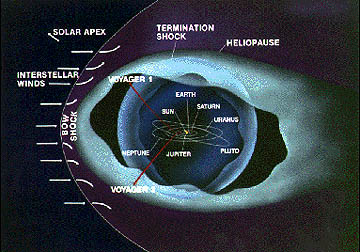The dynamic heliosphere, variable
cosmic environments and their imprints in Earth s archives
The first meeting was held from 18. - 22. April 2005.
The next meeting will be held from 27. - 31. March 2006.





(Klick on the heliopshere to see a movie)
Abstract:
During its orbit around the galactic center the heliosphere reacts to
the changes in the interstellar medium. In addition the interstellar
medium may vary substantially, when the solar system passes through
galactic spiral arms with increased star formation rate and hence a
possibly increased cosmic ray flux. During the past thousand to
millions of years the cosmic ray fluxes could be monitored in the
terrestrial cosmogenic isotopes, which are born in the atmosphere by
the bombardment with cosmic rays and then deposited in sediments, ice
cores, meteorites etc. Therefore the cosmogenic isotopes can be used as
tracers of the cosmic ray flux at Earth. Because cosmic rays are
strongly modulated during their propagation through the heliosphere,
the sophisticated cosmic ray transport model, developed by the South
African group, shall be used and combined with the hydrodynamic
five-fluid Bonn model of the large-scale heliosphere to describe the
state and dynamics of the heliosphere during the past. As input to
these models the cosmic ray flux required for the observed cosmogenic
isotope production rate shall be used. This model will be tested
against the observations from spacecraft (e.g. Ulysses), concerning the
relevant heliospheric parameters, like solar wind states and high
energetic particle fluxes. Based on this information the past galactic
environment around the solar system will be reconstructed with help of
the cosmogenic archives.
Team members:
Klaus Scherer (lead),
Universität Bochum, D-44780 Bochum,
Germany
Jürg Beer, EAWAG, 133
Dübendorf, CH-8600, Switzerland
Hans-Jörg Fahr,
Universität Bonn, 53121 Bonn,
Germany,
Stefan Ferreira,
North-West
University, Campus Potchefstroom, South
Africa
Horst Fichtner,
Ruhr-Universität
Bochum, 44780 Bochum,
Germany
Bernd Heber,
Christian-Albrechts-Universität, D-24118 Kiel,
Germany
Ulrich Langner, North-West
University, Campus Potchefstroom,
South Africa,
Jozef
Masarik, Komensky University, Bratislava, Slovakia
Marius Potgieter,
North-West
University, Campus Potchefstroom, South
Africa
Nir J. Shaviv, Hebrew
University Jerusalem, 91904 Israel
Jan Veizer,
University of Ottawa, Ontario K1N 6N5, Canada
Ararat Yeghikyan, Byurakan
Astrophysical Observatory, Byurakan 378433,
Armenia
Frank Arnold
Ruprecht-Karls-Universität, 69120 Heidelberg, Germany
Ulrike Lohmann
ETH Zürich, Switzerland









